-
RESEARCH01-01-2018
Good practices of labor and birth care from the perspective of health professionals
Revista Brasileira de Enfermagem. 2018;71:1313-1319
Abstract
RESEARCHGood practices of labor and birth care from the perspective of health professionals
Revista Brasileira de Enfermagem. 2018;71:1313-1319
DOI 10.1590/0034-7167-2016-0661
Views0See moreABSTRACT
Objective:
Determine the understanding of health professionals of an obstetric hospital regarding the good practices of labor and birth care recommended by the World Health Organization.
Method:
Research-initiative, with data collection between April and July 2016 using the focal group technique, with 27 health professionals of an obstetric hospital of Rio Grande do Sul with 21 hospitalization beds.
Results:
Three thematic categories were achieved: good obstetric practices and their meanings; from the biological character to singular and multidimensional care; from the punctual and fragmented conception to the labor and birth care network.
Conclusion:
Good practices, in addition to enabling rethinking the obstetric model and contributing to organize the maternal and child health care network in order to ensure access, humane care, and problem-solving capacity, also foster female protagonism.
-
RESEARCH01-01-2018
Intimate partner violence among postpartum women: associated factors
Revista Brasileira de Enfermagem. 2018;71:1306-1312
Abstract
RESEARCHIntimate partner violence among postpartum women: associated factors
Revista Brasileira de Enfermagem. 2018;71:1306-1312
DOI 10.1590/0034-7167-2016-0643
Views0See moreABSTRACT
Objective:
To identify the profile and assess the self-esteem of postpartum women, to characterize their babies and partners, and to verify the association of these characteristics with the occurrence of intimate partner violence (IPV).
Method:
Cross-sectional study with 207 postpartum women assisted in a public clinic.
Results:
There was no statistic correlation among the sociodemographic variables, personal and obstetric characteristics with the occurrence of IPV. The postpartum women who showed low self-esteem presented a higher exposure risk to IPV (p<0.01; OR=2.01 and CI 95% [1.40-2.87]). The mothers of the babies that were born with low weight (less than 2,500 g) had almost twice the chances of suffering violence (p<0.05; OR=1.74 and CI 95% [1.00-3.03]). The women whose partners did not consume alcohol presented a lower probability to be exposed to IPV (p<0.05; OR=0.182 and CI 95% [0.03-0.93]).
Conclusion:
Women’s low self-esteem, babies’ inappropriate weight and consumption of alcohol by partners were correlated to the occurrence of IPV.
-
RESEARCH01-01-2018
Family composing the soundtrack of its reintegration: a theoretical model
Revista Brasileira de Enfermagem. 2018;71:1298-1305
Abstract
RESEARCHFamily composing the soundtrack of its reintegration: a theoretical model
Revista Brasileira de Enfermagem. 2018;71:1298-1305
DOI 10.1590/0034-7167-2017-0485
Views0See moreABSTRACT
Objective:
to understand the meaning of the family’s reintegration attributed by the family experiencing it and to construct a representative theoretical model of this experience.
Method:
this is a qualitative study, conducted with four families with a total of 20 interviewees, with Symbolic Interactionism as theoretical framework, Grounded Theory as methodological, participant observation and the experience of musical making, mediating the interview as strategies of data collection.
Results:
a comparative analysis of the data led to the identification of the main category and to the construction of the theoretical model TRYING TO REBUILD WHAT WAS BROKEN.
Conclusion:
the family experiencing reintegration lives a process of reconstruction that allows to revisit situations of abandonment and review the behavior of caring and re-meaning of family coexistence. For the health professional, this study invites to think about this theme and to review the concept of family, in order to create their own sense of care.
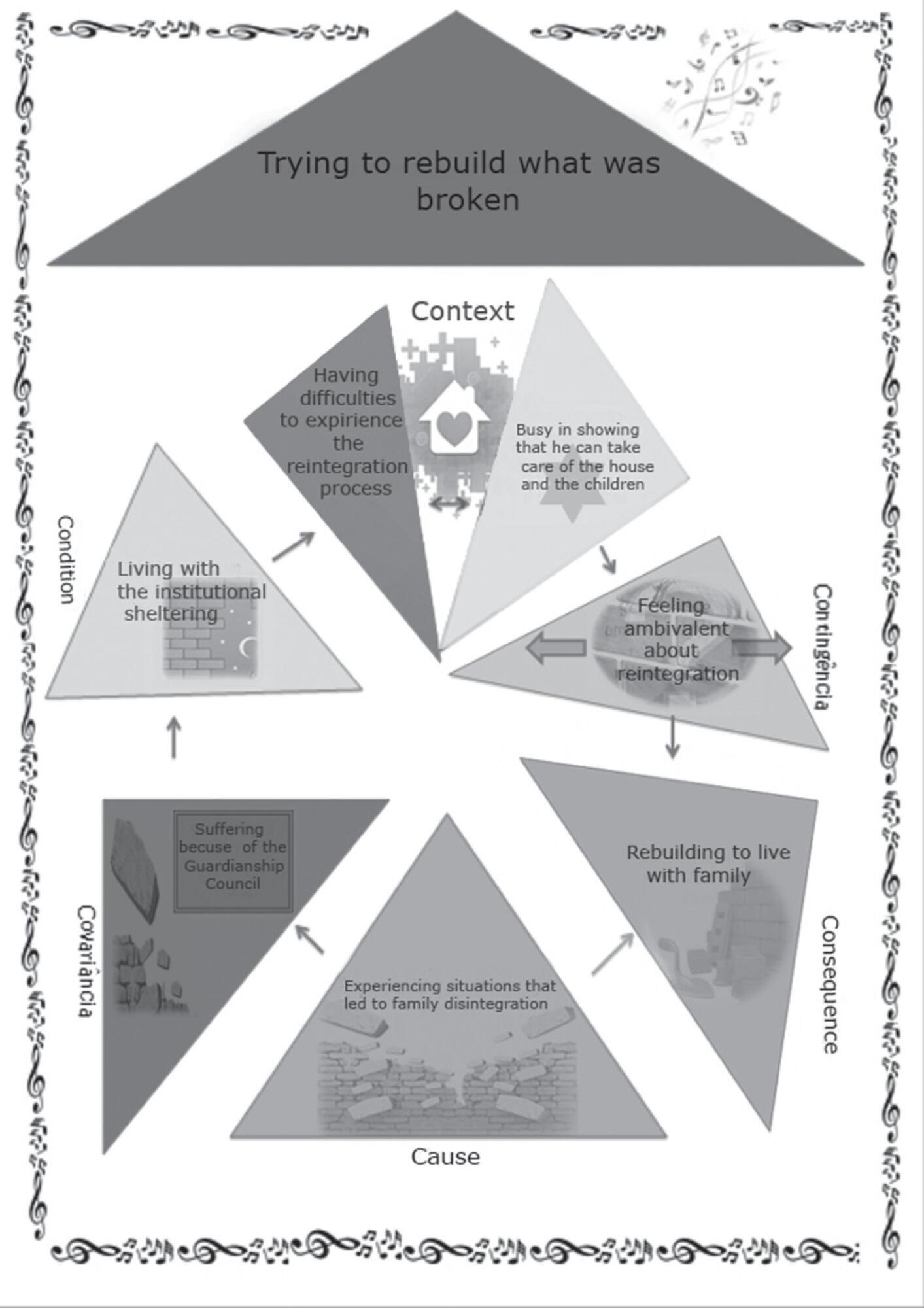
-
RESEARCH01-01-2018
Educational technology to mediate care of the “kangaroo family” in the neonatal unit
Revista Brasileira de Enfermagem. 2018;71:1290-1297
Abstract
RESEARCHEducational technology to mediate care of the “kangaroo family” in the neonatal unit
Revista Brasileira de Enfermagem. 2018;71:1290-1297
DOI 10.1590/0034-7167-2017-0156
Views0See moreABSTRACT
Objective:
to validate the content of an educational technology in the form of a booklet developed to mediate care of family members of newborns hospitalized in a neonatal unit.
Method:
Methodological research with content validation. Data collected from October 2011 to February 2012; research developed in three steps: development, evaluation and adaptation. The study population was 15 judges, health professionals and other professionals. The participants answered a Likert-type questionnaire with 3 blocks of evaluative items. Data were analyzed statistically.
Results:
validation reached the results proposed in most responses (80%); 16 items exceeded the parameter, 4 were equal to the score established and 2 were below the parameter.
Conclusion:
the content of educational technologies need to be validated. The booklet, after the evaluation, constitutes an adequate device to mediate care of the family members in the NICU.

-
RESEARCH01-01-2018
Assistance flowchart for pain management in a Neonatal Intensive Care Unit
Revista Brasileira de Enfermagem. 2018;71:1281-1289
Abstract
RESEARCHAssistance flowchart for pain management in a Neonatal Intensive Care Unit
Revista Brasileira de Enfermagem. 2018;71:1281-1289
DOI 10.1590/0034-7167-2017-0265
Views0See moreABSTRACT
Objective:
To describe and discuss the process of developing a flowchart collectively constructed by the health team of a Neonatal Intensive Care Unit for the management of neonatal pain.
Method:
This is a descriptive and an exploratory study with a qualitative approach that used Problem-Based Learning as a theoretical-methodological framework in the process of developing the assistance flowchart for the management of neonatal pain.
Results:
Based on this methodology, there was training in service and the discussion of key points of pain management by the health team, which served as input for the construction of the flowchart.
Final considerations:
The assistance flowchart for pain management, based on scientific evidence, provided means to facilitate the decision-making of the health team regarding the pain of the newborn. It is suggested to use the flowchart frequently to promote the permanent education of the team and identify possible points to be adjusted.
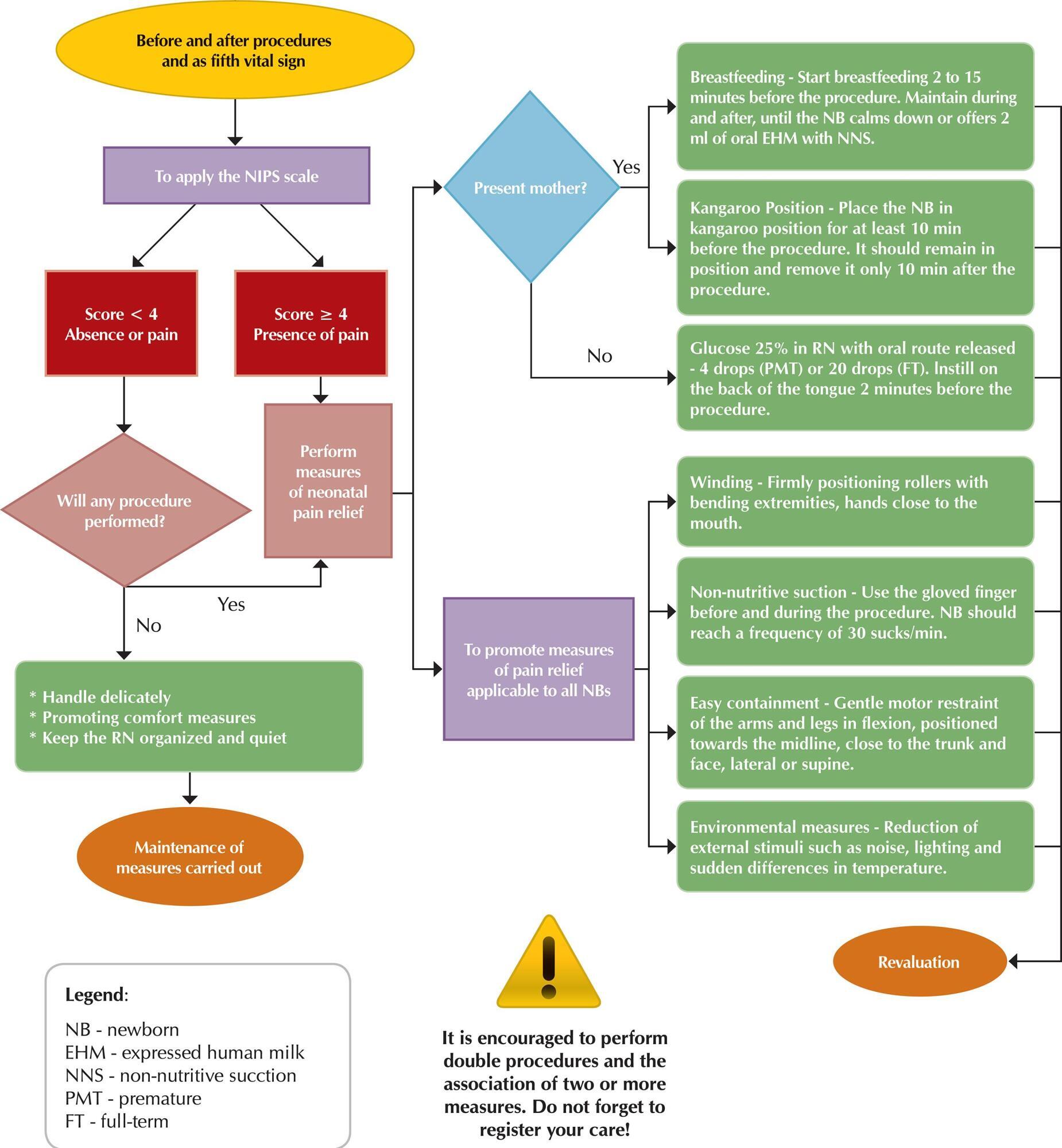
-
RESEARCH01-01-2018
Computerized nursing process: development of a mobile technology for use with neonates
Revista Brasileira de Enfermagem. 2018;71:1273-1280
Abstract
RESEARCHComputerized nursing process: development of a mobile technology for use with neonates
Revista Brasileira de Enfermagem. 2018;71:1273-1280
DOI 10.1590/0034-7167-2017-0267
Views0See moreABSTRACT
Objective:
to build a mobile technology to assist nurses during data collection, diagnostic reasoning, and identification of interventions in neonates.
Method:
methodological study with a qualitative approach. The development was carried out in three phases, namely: bibliographical survey, construction of a database of diagnosis/interventions, and development of the software. We used the development tools Ruby on Rails, IONIC 2, PostgresSQL, and Amazon EC2.
Results:
The developed technology received the name Natus, able to contribute to the development of the nursing process applied to patients of neonatal units. Its requirements are: to define human needs, select nursing diagnoses, select interventions, define time periods, and issue printed files.
Final considerations:
the technology built is a computerized tool that allows for the development of the nursing process, facilitating data collection, diagnostic reasoning, and identification and grouping of the clinical signs presented by the newborn in neonatal units.

-
RESEARCH01-01-2018
The maternity ward of a teaching hospital: reconfiguration of maternal-child nursing care
Revista Brasileira de Enfermagem. 2018;71:1265-1272
Abstract
RESEARCHThe maternity ward of a teaching hospital: reconfiguration of maternal-child nursing care
Revista Brasileira de Enfermagem. 2018;71:1265-1272
DOI 10.1590/0034-7167-2016-0585
Views0See moreABSTRACT
Objective:
to analyze the strategies used by nurses and nurse professors for a better position in the maternity ward of the teaching hospital of the Universidade Federal do Espírito Santo.
Method:
this is a social-historical study with a qualitative approach. The primary sources were written documents, such as official letters, memos, ordinances, standards and routines of the hospital; photographic material; and oral testimonies from seven participants. The interviews were performed using a semi-structured questionnaire, with questions regarding the adaptation from a sanatorium to a teaching hospital, the challenges faced, and the strategies adopted by the nursing department.
Results:
the results allowed us to understand the close link between the maternity ward and the nursing course of the Universidade Federal do Espírito Santo, which created a differentiated nursing care that integrated training and care with a broader and humanized look.
Final considerations:
the actions of the nurses were recognized and gave them professional visibility, influencing a new form of care in the maternity ward.
-
RESEARCH01-01-2018
The work of nurses in high-risk prenatal care from the perspective of basic human needs
Revista Brasileira de Enfermagem. 2018;71:1257-1264
Abstract
RESEARCHThe work of nurses in high-risk prenatal care from the perspective of basic human needs
Revista Brasileira de Enfermagem. 2018;71:1257-1264
DOI 10.1590/0034-7167-2017-0328
Views1See moreABSTRACT
Objective:
To analyze the work of nurses in high-risk prenatal care in secondary care, considering nursing problems and the basic human needs of pregnant women.
Method:
Cross-sectional and quantitative study, developed in a high-risk prenatal care clinic. Data were selected in the records of the nursing consultation. The studied variables were related to sociodemographic and obstetric characteristics, in addition to nursing problems. We performed the descriptive analysis of the data and the grouping of nursing problems within the levels of Basic Human Needs (BHN).
Results:
We evaluated 54 nursing consultations of pregnant women, mostly young, multiparous, and with nine or more years of study. Every pregnant woman reported, on average, 7.4 nursing problems. The psychobiological BHN prevailed in relation to psychosocial ones.
Conclusion:
In high-risk prenatal care, nurses can use the nursing consultation considering their mastery of light technologies to engage with hard and light-hard technologies.
-
REVIEW10-28-2020
Health care of sexual and gender minorities: an integrative literature review
Revista Brasileira de Enfermagem. 2020;73:e20190192
Abstract
REVIEWHealth care of sexual and gender minorities: an integrative literature review
Revista Brasileira de Enfermagem. 2020;73:e20190192
DOI 10.1590/0034-7167-2019-0192
Views0See moreABSTRACT
Objectives:
to describe health care practices aimed at lesbians, gays, bisexuals, transvestites, and transsexuals.
Methods:
an integrative literature review based on systematic steps, in MEDLINE, LILACS AND SciELO databases and/or electronic libraries. It was held from September to November 2018, with articles published between 2012 and 2017, available in full in Portuguese, English, and Spanish, addressing health care to that population group.
Results:
fourteen articles were included. Most of the articles were about the trajectory of individuals within health services and showed limitations and obstacles in the use of these services.
Final Considerations:
there is evidence that factors related to organization of services, attitude of professionals, stigma, and discrimination experienced undermine health care practices. Therefore, it is essential to carry out educational activities in health services and educational institutions.
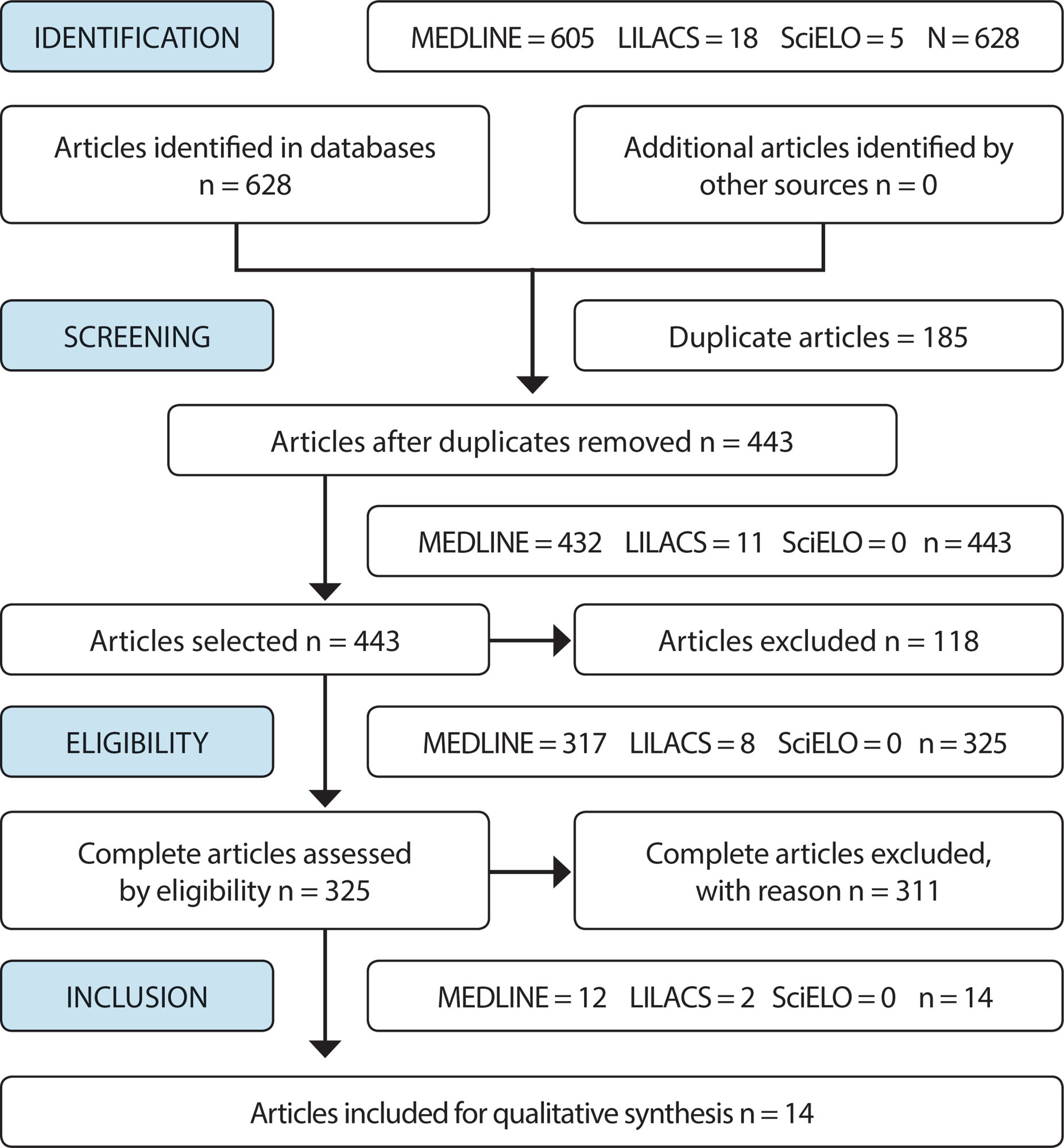
-
ORIGINAL ARTICLE07-06-2020
Nurses’ work process in an emergency hospital service
Revista Brasileira de Enfermagem. 2020;73(5):e20180923
Abstract
ORIGINAL ARTICLENurses’ work process in an emergency hospital service
Revista Brasileira de Enfermagem. 2020;73(5):e20180923
DOI 10.1590/0034-7167-2018-0923
Views1See moreABSTRACT
Objectives:
to analyze the nurses’ work process in an Emergency Hospital Service.
Methods:
a qualitative, exploratory and descriptive research conducted with 17 nurses from the emergency service of a high complexity hospital in southern Brazil. Data were collected through interviews, focus group and document analysis. Data analysis followed the thematic content analysis framework.
Results:
four categories emerged: Work environment characteristics; Assistance dimension; Management dimension; Care management.
Final Considerations:
the nurses’ work process in Emergency Hospital Service is characterized by the peculiarities of the setting, with centrality in care and care management aiming at quality care and safety to patients.
-
EXPERIENCE REPORT09-29-2022
Mobile pre-hospital care reorganization during the COVID-19 pandemic: experience report
Revista Brasileira de Enfermagem. 2022;75:e20200826
Abstract
EXPERIENCE REPORTMobile pre-hospital care reorganization during the COVID-19 pandemic: experience report
Revista Brasileira de Enfermagem. 2022;75:e20200826
DOI 10.1590/0034-7167-2020-0826
Views0See moreABSTRACT
Objective:
To describe the reorganization of Belo Horizonte’s Mobile Emergency Care Service during the new coronavirus pandemic using the Plan Do-Check-Act quality tool.
Methods:
Descriptive study, of the experience report type, on the reorganization of care in a mobile pre-hospital care service during the new coronavirus pandemic, from March to July 2020. The Plan-Do-Check-Act quality tool was applied for the process.
Results:
Preparation of care protocol, meetings, training, addition of ambulances, hiring of professionals, and other actions were carried out, with subsequent evaluation and monitoring. When failures or new needs were identified, actions and changes were implemented while keeping monitoring and evaluation during the work routine.
Final considerations:
The reorganization of the service through the construction of a protocol and using the Plan-Do-Check-Act as a management tool was essential to promote safe care for professionals and patients.

-
ORIGINAL ARTICLE09-21-2020
Adolescents in situations of poverty: resilience and vulnerabilities to sexually transmitted infections
Revista Brasileira de Enfermagem. 2020;73:e20190242
Abstract
ORIGINAL ARTICLEAdolescents in situations of poverty: resilience and vulnerabilities to sexually transmitted infections
Revista Brasileira de Enfermagem. 2020;73:e20190242
DOI 10.1590/0034-7167-2019-0242
Views0See moreABSTRACT
Objective:
To analyze the association between vulnerabilities to Sexually Transmitted Infections (STIs/HIV/AIDS) of adolescents in poverty and their level of resilience.
Method:
Cross-sectional study with 287 students between 11 and 17 years old in a school in the outskirts of Fortaleza-Ce. The study was conducted from August to October 2016. Three instruments related to characterization, vulnerability to STIs/HIV/AIDS and resilience were used. The association between the instruments was calculated using the Mann-Whitney and Kruskal-Wallis tests. Association between vulnerability to STIs/HIV/AIDS and resilience was assessed through the Spearman’s correlation coefficient. Statistical significance was set at p<0.05.
Results:
There was a significant association between the factors “housing” (p=0.022), “family income” (p=0.037) and vulnerability to STIs/HIV/AIDS. Adolescents whose father has completed high school (p=0.043) have moderately high resilience.
Conclusion:
Adolescents with low socioeconomic status and who live on less than a minimum wage tends to be more susceptible to vulnerabilities to STIs/HIV/AIDS and to have low resilience.
-
ORIGINAL ARTICLE06-14-2021
Mothers’ knowledge of premature newborn care and application of Kangaroo Mother Care at home
Revista Brasileira de Enfermagem. 2021;74(6):e20200717
Abstract
ORIGINAL ARTICLEMothers’ knowledge of premature newborn care and application of Kangaroo Mother Care at home
Revista Brasileira de Enfermagem. 2021;74(6):e20200717
DOI 10.1590/0034-7167-2020-0717
Views0See moreABSTRACT
Objective:
to identify mothers’ knowledge about premature newborn care and application of Kangaroo Mother Care at home.
Methods:
a descriptive, qualitative study carried out with 15 mothers of premature newborns in a reference Maternal and Child Hospital in northern Brazil using two semi-structured interviews with open- and closed-ended questions. The testimonies were analyzed using thematic analysis technique, proposed by Bardin.
Results:
two thematic categories originated: “Caring for a premature newborn at home: strengths and weaknesses” and “Applying Kangaroo Mother Care at home: new knowledge acquired during hospitalization”.
Final considerations:
the speeches of the interviewed mothers pointed out their knowledge about home care of premature NBs and understanding the importance of Kangaroo Mother Care, mainly acquired and improved with the guidance of professionals during hospitalization and application of the method, in addition to fears, possible difficulties in home care and the need to be better informed at hospital discharge.
-
ORIGINAL ARTICLE10-01-2022
Musculoskeletal symptoms in formal and informal caregivers of elderly people
Revista Brasileira de Enfermagem. 2022;75(2):e20210249
Abstract
ORIGINAL ARTICLEMusculoskeletal symptoms in formal and informal caregivers of elderly people
Revista Brasileira de Enfermagem. 2022;75(2):e20210249
DOI 10.1590/0034-7167-2021-0249
Views0See moreABSTRACT
Objective:
to evaluate musculoskeletal symptoms in formal and informal caregivers of elderly people, and check association with personal and work-related factors.
Methods:
this is a cross-sectional study. Instruments for assessment were the International Physical Activity Questionnaire, Self-Reporting Questionnaire-20, Borg’s effort perception scale and Nordic Musculoskeletal Questionnaire.
Results:
informal caregivers had been working for a longer time (60.2% vs. 41%), had more hours of work (37.4% >12h for day), less time off (85.4% vs. 2.5%) and lack of care guidelines (90.2%). The region with the most musculoskeletal symptoms was the spine and the greater dependence of the elderly, the greater the chances of developing musculoskeletal symptoms (OR= 1.3, 95% CI= 1.1-1.6, p <0.05).
Conclusion:
personal and work-related factors were more prevalent in informal group and the elderly person’s dependence interferes with the increase in musculoskeletal symptoms of caregivers.
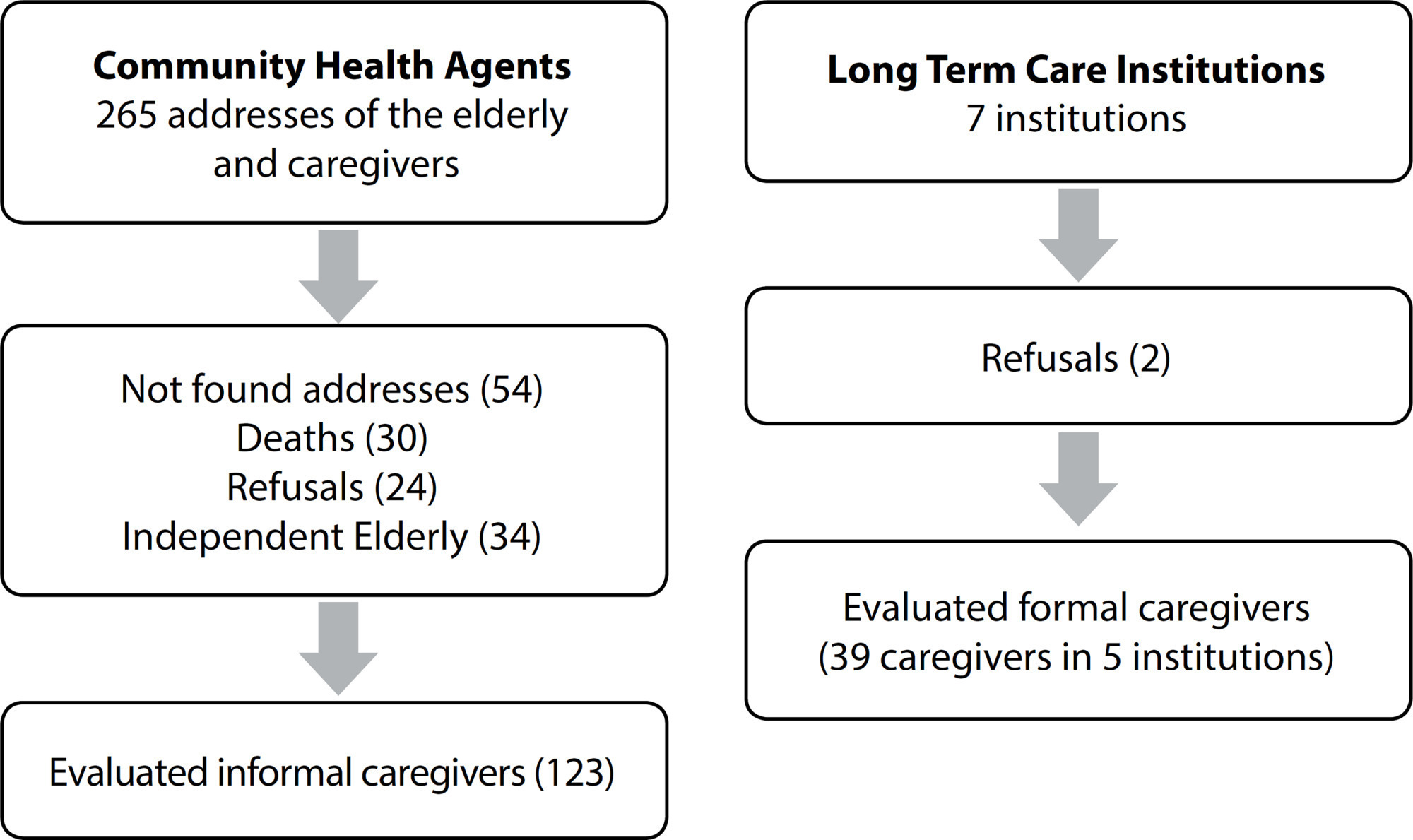
-
REVIEW11-25-2020
Nurse’s interventions in preventing falls in hospitalized children: scoping review
Revista Brasileira de Enfermagem. 2020;73:e20190409
Abstract
REVIEWNurse’s interventions in preventing falls in hospitalized children: scoping review
Revista Brasileira de Enfermagem. 2020;73:e20190409
DOI 10.1590/0034-7167-2019-0409
Views1See moreABSTRACT
Objectives:
map both nursing interventions for the prevention of falls in paediatric age during hospitalization and the instruments for assessing the risk of falls in paediatrics.
Methods:
scoping review according to the protocol of Joanna Briggs Institute, with acronym PCC (P – children, C – fall preventive nursing interventions and instruments for assessing the risk of falling, C – hospital admission), in three sources of information (EBSCO, PubMed and SciELO).
Results:
the sample consisted of seven articles. The education of the child/family is the basis of the interventions, and the instruments for assessing the risk of falling identified were: Humpty Dumpty Falls Scale, GRAF PIF, CUMMINGS, I’M SAFE and CHAMPS.
Conclusions:
the education of children/parents on preventive measures is important and should be reinforced during hospitalization, using different methodologies. The Humpty Dumpty Falls Scale was the most analyzed.
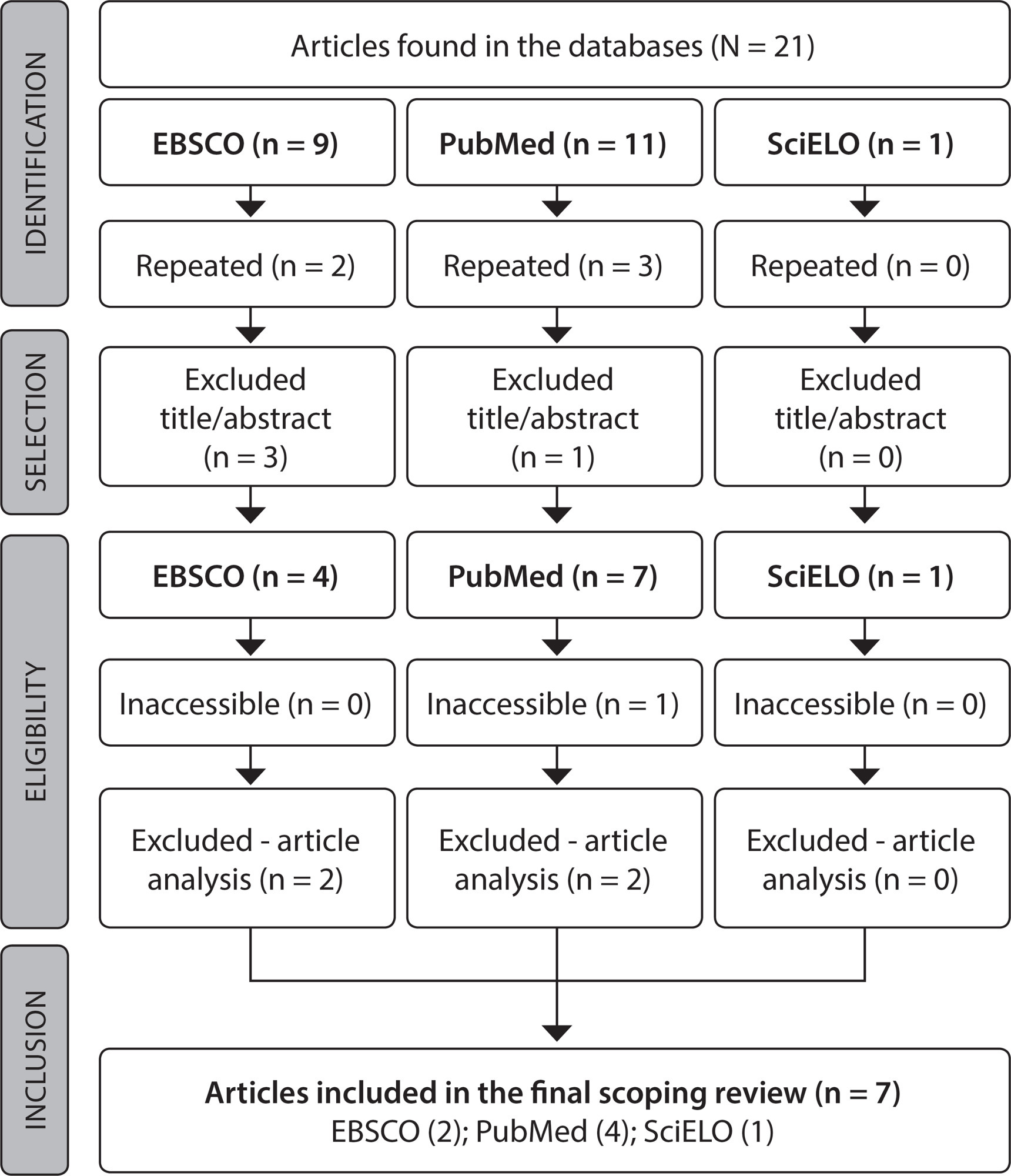
-
ORIGINAL ARTICLE07-10-2020
Formation of protagonist adolescents to prevent bullying in school contexts
Revista Brasileira de Enfermagem. 2020;73:e20190418
Abstract
ORIGINAL ARTICLEFormation of protagonist adolescents to prevent bullying in school contexts
Revista Brasileira de Enfermagem. 2020;73:e20190418
DOI 10.1590/0034-7167-2019-0418
Views0See moreABSTRACT
Objective:
to develop a participative strategy of health education in the formative process of protagonist adolescents aimed at preventing school bullying.
Method:
qualitative interventive-participatory research, based on the Community-Based Participatory Research and in the Culture Circles of Paulo Freire. The sample was intentional, with the participation of 12 adolescents who were considered leaders. For data production at the moment of educational intervention, observation techniques were employed with note-taking in a field diary, plus photographic and video records.
Results:
the pedagogical intervention model raised the opportunity for the adolescents’ active participation, aiming at the development of skills that create pro-social behaviors, empathetic and assertive relations, which are able to face bullying and transform the school environment.
Final considerations:
the use of participative methodologies, in the youth protagonism perspective, has the potential to support educational practices of school nurses in collaboration and leadership of antibullying programs.
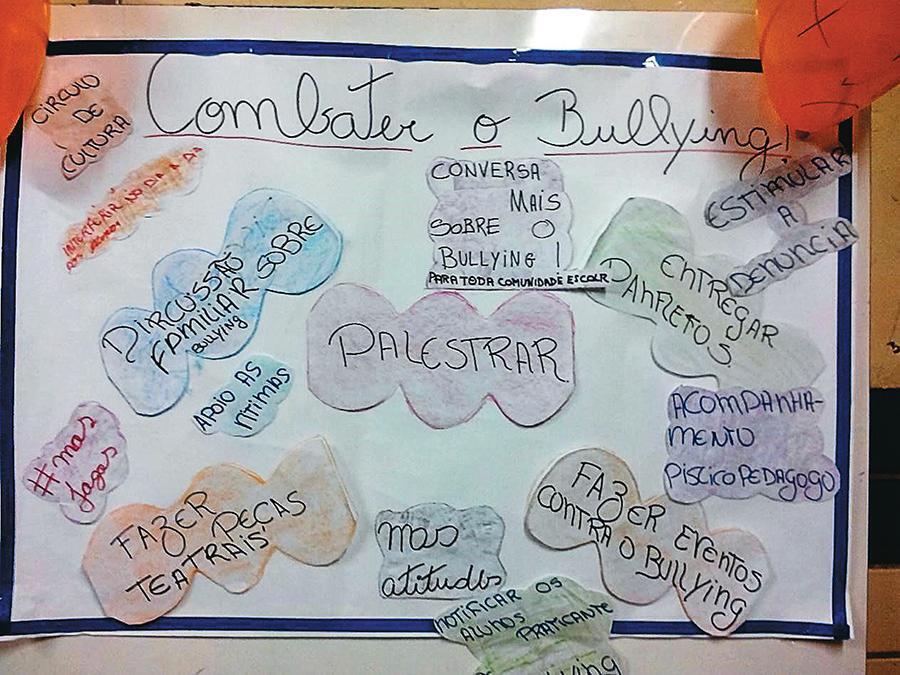
Search
Search in:
Nuvem de Tags
Adolescente (85) Atenção Primária à Saúde (239) COVID-19 (91) Criança (91) Cuidados de Enfermagem (269) Educação em Enfermagem (151) Educação em Saúde (139) Enfermagem (930) Enfermagem Pediátrica (86) Estudantes de Enfermagem (77) Estudos de Validação (131) Família (87) Idoso (208) Promoção da Saúde (99) Qualidade de Vida (104) Saúde do Trabalhador (86) Saúde Mental (145) Saúde Pública (82) Segurança do Paciente (150) Tecnologia Educacional (100)



